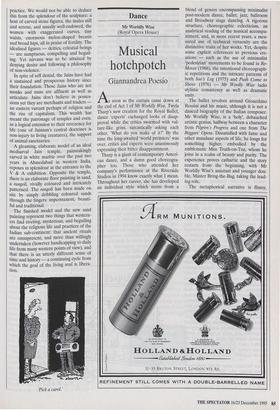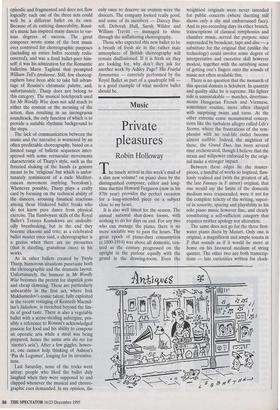Dance
Mr Worldly Wise (Royal Opera House)
Musical hotchpotch
Giannandrea Poesio
Asoon as the curtain came down at the end of Act 1 of Mr Worldly Wise, Twyla Tharp's new creation for the Royal Ballet, dance 'experts' exchanged looks of disap- proval while the critics swarmed with vul- ture-like grins, sarcastically asking each other, 'What do you make of it?' By the time the long-awaited 'world premiere' was over, critics and experts were unanimously expressing their bitter disappointment.
Tharp is a giant of contemporary Ameri- can dance, and a damn good choreogra- pher too. Those who attended her company's performance at the Riverside Studios in 1994 know exactly what I mean. Throughout her career, she has developed an individual style which stems from a
blend of genres encompassing minimalist post-modern dance, ballet, jazz, ballroom and Broadway stage dancing. A rigorous structure, choreographic eclecticism, an analytical reading of the musical accompa- niment, and, in more recent years, a mea- sured use of technical virtuosity are the distinctive traits of her works. Yet, despite some explicit references to previous cre- ations — such as the use of minimalist `pedestrian' movements to be found in Re- Moves (1966), the intentional choreograph- ic repetitions and the intricate patterns of both Sue's Leg (1975) and Push Come to Shove (1976) — Mr Wordly Wise lacks stylistic consistency as well as dramatic unity.
The ballet revolves around Gioacchino Rossini and his music, although it is not a danced biography of the Italian composer. Mr Worldly Wise, is a 'holy', debauched artistic genius, halfway between a character from Pilgrim's Progress and one from The Beggars' Opera. Dissatisfied with fame and other mundane aspects of life, he longs for something higher, embodied by the emblematic Miss Truth-on-Toe, whom he joins in a realm of beauty and purity. The experience proves cathartic and the story restarts from the beginning, with Mr Worldly Wise's assistant and younger dou- ble, Master Bring-the-Bag, taking the lead- ing role.
The metaphorical narrative is flimsy, episodic and fragmented and does not flow logically: each one of the three acts could well be a different ballet on its own. Because of its enticing danceability, Rossi- ni's music has inspired many dances to var- ious degrees of success. The great composer wrote some of the best music ever contrived for choreographic purposes (including an entire ballet recently redis- covered), and was a fond ballet-goer him- self: it was his admiration for the Romantic ballerina Marie Taglioni that prompted William Tell's tyrolienne. Still, few choreog- raphers have been able to take full advan- tage of Rossini's chromatic palette, and, unfortunately, Tharp does not belong to this category. The musical hotchpotch used for Mr Worldly Wise does not add much to either the content or the meaning of the action, thus resulting in an incongruous soundtrack, the only function of which is to provide a suitable rhythmic background to the steps.
The lack of communication between the music and the narrative is worsened by an often predictable choreography, based on a limited range of balletic sequences inter- spersed with some vernacular movements characteristic of Tharp's style, such as the frenzied shaking of the hands (a gesture meant to be 'religious' but which is unfor- tunately reminiscent of a rude Mediter- ranean movement implying 'boredom'). Whenever possible, Tharp plays a crafty card by focusing on the technical ability of the dancers, arousing fanatical reactions among those blinkered ballet freaks who do not know pure dance from physical exercise. The flamboyant skills of the Royal Ballet's Tetsuya Kumakawa are undoubt- edly breathtaking, but in the end they become irksome and trite; as a celebrated ballet master once said, a choreographer is a genius when there are no pirouettes (that is dazzling, gratuitous ones) in his works.
As in other ballets created by Twyla Tharp, humorous situations punctuate both the choreographic and the dramatic layout. Unfortunately, the humour in Mr Wordly Wise becomes the pretext for slapstick jests and cheap clowning. These are particularly unbearable in the first act, where Irek Mukhamedov's comic talent, fully exploited in the recent restaging of Kenneth Macmil- lan's Sideshow, is stretched beyond the lim- its of good taste. There is also a vegetable ballet with a scene-stealing aubergine, pos- sibly a reference to Rossini's acknowledged passion for food and his ability to compose an operatic aria while a meal was being prepared, hence the name aria dei risi (or `risotto's aria'). After a few giggles, howev- er, one cannot help thinking of Ashton's `Pas de Legumes', longing for its inventive- ness.
Last Saturday, none of the tricks went astray: people who liked the ballet duly laughed when they were supposed to and clapped whenever the musical and choreo- graphic cues demanded. In my opinion, the only ones to deserve an ovation were the dancers. The company looked really good, and some of its members — Darcey Bus- sell, Deborah Hull, Sarah Wildor and William Trevitt — managed to shine through the unflattering choreography.
Those who expected this new ballet to be a breath of fresh air in the rather stale atmosphere of British choreography will remain disillusioned. If it is fresh air they are looking for, why don't they ask for another work by Ashley Page? His Fearful Symmetries — currently performed by the Royal Ballet as part of a quadruple bill is a good example of what modern ballet should be.











































































































 Previous page
Previous page